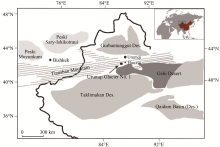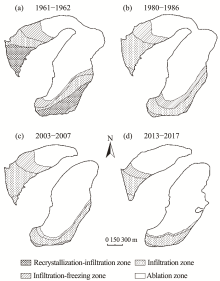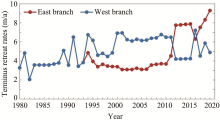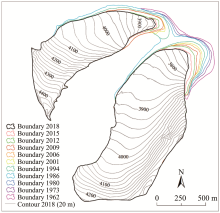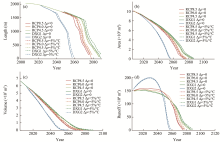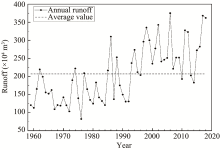Sciences in Cold and Arid Regions ›› 2020, Vol. 12 ›› Issue (6): 380–388.doi: 10.3724/SP.J.1226.2020.00380
60-year changes and mechanisms of Urumqi Glacier No. 1 in the eastern Tianshan of China, Central Asia
ZhongQin Li( ),HuiLin Li,ChunHai Xu,YuFeng Jia,FeiTeng Wang,PuYu Wang,XiaoYing Yue
),HuiLin Li,ChunHai Xu,YuFeng Jia,FeiTeng Wang,PuYu Wang,XiaoYing Yue
- Tianshan Glaciological Station/State Key Laboratory of Cryospheric Sciences, Northwest Institute of Eco-Environment and Resources, Chinese Academy of Sciences, Lanzhou, Gansu 730000, China
| Atsumu O, 2011. Foreword. Journal of Earth Science, 22(4): 421-422. | |
|
Braithwaite RJ, 2002. Glacier mass balance: the first 50 years of international monitoring. Progress in Physical Geography, 26(1): 76-95. DOI: 10.1191/0309133302pp326ra.
doi: 10.1191/0309133302pp326ra |
|
|
Dyurgerov MB, Meier MF, 2000. Twentieth century climate change: evidence from small glacier. Proceedings of the National Academy of Sciences, 97(4): 1406-1411. DOI: 10.1073/pnas.97.4.1406.
doi: 10.1073/pnas.97.4.1406 |
|
| Elder K, Kattelmann R, Ushnurtsev SN, et al., 1992. Differences in mass-balance calculations resulting from alternative sampling and estimation techniques on Glacier No. 1, Tien Shan, China. Annals of Glaciology, 16: 198-206. | |
|
Fujita K, 2008. Influence of precipitation seasonality on glacier mass balance and its sensitivity to climate change. Annals of Glaciology, 48: 88-92. DOI: 10.3189/172756408784700824.
doi: 10.3189/172756408784700824 |
|
|
Haeberli W, Holzhauser H, 2003. Alpine glacier mass changes during the past two millennia. Pages News, 11(1): 13-15. DOI: 10.22498/pages.11.1.13.
doi: 10.22498/pages.11.1.13 |
|
|
Harper JT, 1993. Glacier terminus fluctuations on Mount Baker, Washington, USA, 1940-1990, and climatic variations. Arctic and Alpine Research, 25(4): 332-340. DOI: 10.2307/1551916.
doi: 10.2307/1551916 |
|
|
Huss M, Hock R, 2018. Global-scale hydrological response to future glacier mass loss. Nature Climate Change, 8(2): 135-140. DOI:10.1038/s41558-017-0049-x.
doi: 10.1038/s41558-017-0049-x |
|
| Ji ZP, Tang MC, 1994. A study on data interpolation and prediction of annual mass balance of Glacier No. 1 at the source. Journal of Glaciology and Geocryology, 16(2): 128-137. (in Chinese) | |
|
Jia YF, Li ZQ, Jin S, et al., 2020. Runoff Changes from Urumqi Glacier No. 1 over the Past 60 Years, Eastern Tianshan, Central Asia. Water, 12(5): 1286. DOI: 10.3390/w12051286.
doi: 10.3390/w12051286 |
|
| Kang ES, Shi YF, Yang DQ, et al., 1997. An Experimental Study on Runoff Formation in the Mountains Basin of the Urumqi River. Quaternary Sciences, 2: 139-146. | |
|
Li HL, Ng F, Li ZQ, et al., 2012. An extended "perfect-plasticity" method for estimating ice thickness along the flow line of mountain glaciers. Journal of Geophysical Research Earth Surface, 117: F01020. DOI: 1029/2011JF002104.
doi: 1029/2011JF002104 |
|
| Li ZQ, 2019, Simulation of Mass Balance and Dynamic Processes of Mountain Glaciers. Science Press, Beijing. (in Chinese) | |
|
Li ZQ, Edwards R, Mosley-Thompson E, et al., 2006. Seasonal variability of ionic concentrations in surface snow and elution processes in snow-firn packs at PGPI site on Urumqi Glacier No.1, eastern Tien Shan, China. Annals of Glaciology, 43: 250-256. DOI: 10.3189/172756406781812069.
doi: 10.3189/172756406781812069 |
|
| Li ZQ, Han TD, Jing ZF, 2003. 40-year observed variation facts of climate and Glacier No. 1 at the headwaters of Urumqi River. Journal of Glaciology and Geocryology, 25(2): 117-123. (in Chinese) | |
|
Li ZQ, Li HL, Chen YN, et al., 2011. Mechanisms and simulation of accelerated shrinkage of continental glaciers: a case study of Urumqi Glacier No. 1 in eastern Tianshan, central Asia. Journal of Earth Science, 22(4): 423-430. DOI: 10. 1007/s12583-011-0194-5.
doi: 10. 1007/s12583-011-0194-5 |
|
| Li ZQ, Wang FT, Li HL, et al., 2018. Science and long-term monitoring of continental-type glaciers in arid region in China. Bulletin of Chinese Academy of Sciences, 833(12): 1381-1390. (in Chinese) | |
|
Li ZQ, Wang WB, Zhang MJ, et al., 2010. Observed changes in streamflow at the headwaters of the Urumqi River, eastern Tianshan, central Asia. Hydrological Processes, 24(2): 217-224. DOI: 10.1002/hyp.7431.
doi: 10.1002/hyp.7431 |
|
| Liu CH, 1989. Study on mass balance process of Glacier No.1 at the headwaters of Urumqi River, Tianshan. Annual report of Tianshan Glaciological Station, 8: 1-23. (in Chinese) | |
|
Ludwig P, Schaffernicht EJ, Shao YP, et al., 2016. Regional atmospheric circulation over Europe during the Last Glacial Maximum and its links to precipitation. Journal of Geophysical Research: Atmospheres, 121(5): 2130-2145. DOI: 10.1002/2015jd024444.
doi: 10.1002/2015jd024444 |
|
| Paterson WSB, 1994. The Physics of Glaciers, 3rd edition, Oxford, Pergamon Press. | |
|
Pelto MS, Hedlund C, 2001. The terminus behavior and response time of North Cascade glaciers. Journal of Glaciology, 47(158): 497-506. DOI: 10.3189/172756501781832098.
doi: 10.3189/172756501781832098 |
|
| Shumskii PA, 1964. Principles of Structural Glaciology: The Petrography of Fresh-water Ice as a Method of Glaciological Investigation (translated by D. Kraus). Dover, New York. | |
|
Wang FT, Li ZQ, Edwards R, et al., 2007. Long-term changes in the snow-firn pack stratigraphy on Ürümqi glacier No. 1, eastern Tien Shan, China. Annals of Glaciology, 46: 331-334. DOI: 10.3189/172756407782871198.
doi: 10.3189/172756407782871198 |
|
| Watson CS, White NJ, Church JA, et al., 2015. Unabated global mean sea-level rise over the satellite altimeter era. Nature Climate Change, 5(6): 565-568. | |
| Xie ZC, Ding LF, 1996. Glacier mass balance in high Asia and its response to climate change. Journal of Glaciology and Geocryology, 18: 4-11. (in Chinese) | |
| Xie ZC, Huang M, 1989. Ice Formation in Glaciers of China, In: Introduction to Chinese Glaciers, Beijing: Science Press.(in Chinese) | |
| Xie ZC, Ge G, 1965. Study of accumulation, ablation and mass balance of Glacier No.1 at the headwater of Urumqi River, Tianshan. Study of Glaciology and Hydrology on the Urumqi River, Tianshan (Edited by Beijing Institute of Geography), Beijing: Science Press. (in Chinese) | |
| Xie ZC, Liu CH, 2010. Introduction to Glaciology, Shanghai: Shanghai Popular Science Press. (in Chinese) | |
|
Xu CH, Li ZQ, Li HL, et al., 2019. Long-range terrestrial laser scanning measurements of annual and intra-annual mass balances for Urumqi Glacier No. 1, eastern Tien Shan, China. The Cryosphere, 13(9): 2361-2383. DOI: 10.5194/tc-13-2361-2019.
doi: 10.5194/tc-13-2361-2019 |
|
| Yang ZN, 1991. Glacier Water Resources in China. Lanzhou: Gansu Science and Technology Press, pp. 74-78. (in Chinese) | |
| You XN, Li ZQ, Wang FT, 2005. Study on time scale of snow-ice transformation through snow layer tracing method-Take Glacier No. 1 at the headwaters of Urumqi River as an example. Journal of Glaciology and Geocryology, 27: 853-860. (in Chinese) | |
|
Zemp M, Hoelzle M, Haeberli W, 2009. Six decades of glacier mass-balance observations: a review of the worldwide monitoring network. Annals of Glaciology, 50(50):101-111. DOI: 10.3189/172756409787769591.
doi: 10.3189/172756409787769591 |
|
|
Zemp M, Huss M, Thibert E, et al., 2019. Global glacier mass changes and their contributions to sea-level rise from 1961 to 2016. Nature, 568(7752): 382-386. DOI: 10.1038/s41586-019-1071-0.
doi: 10.1038/s41586-019-1071-0 |
|
| Zhang JH, 1981. Mass balance studies on glacier No.1 in Urumqi River, Tianshan. Journal of Glaciology and Geocryology, 3(1): 32-40. (in Chinese) | |
| Zhang JH, Wang XJ, Li J, 1984. Study of the relationship between mass balance change of Glacier No. 1 at the headwater of Urumqi River, Tianshan and climate. Journal of Glaciology and Geocryology, 6: 25-36. (in Chinese) |
| No related articles found! |

